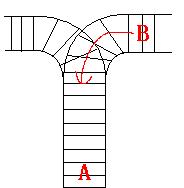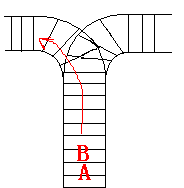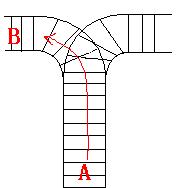////2016.11月,9个月之后偶然发现这道题、又做了一遍,感慨的是,尽管很简单的一道题还是会犯错误,看下面Note。还是做过的题太少了。
1 题意,简单模拟栈。
2 分析
Note:
while((!ss.empty())&&(ss.top()==(com2[cur]-'0')))
①这一句中,!ss.empty()要放在前面,不然在while里不断ss.pop(),ss.top()指到空、就崩溃了:while((ss.top()==(com2[cur]-'0'))&&(!ss.empty()))
②另外,注意是用ss.top()去比较。
③注意这个样例:5 12345 13245
3
#include <iostream>
#include <stdio.h>
#include <stack>
#include <vector>
#include <string.h>
using namespace std;
//5 12345 13245
const int maxn=1010;
int bj=-1;
vector<int> da;
stack <int> ss;
char com1[maxn],com2[maxn];
int Solve(){
int cur=0;
for(int i=0;i<strlen(com1);i++){
ss.push(com1[i]-'0');
da.push_back(1);
while((!ss.empty())&&(ss.top()==(com2[cur]-'0'))){
ss.pop();
cur++;
da.push_back(0);
}
}
while(!ss.empty()){
int temp=ss.top();
ss.pop();
if(temp!=(com2[cur++]-'0')){
return 0;
}
else{
da.push_back(0);
}
if(cur==strlen(com2)&&!ss.empty()){
return 0;
}
}
return 1;
}
int main()
{
int n;
while(~scanf("%d",&n)){
da.clear();
while(!ss.empty())
ss.pop();
scanf("%s%s",com1,com2);
bj=Solve();
if(bj==1){
cout<<"Yes."<<endl;
for(int i=0;i<da.size();i++){
if(da[i]==0) cout<<"out"<<endl;
else cout<<"in"<<endl;
}
}
else
cout<<"No."<<endl;
cout<<"FINISH"<<endl;
}
}
//////
原来写的:
1)模拟题,不要钻牛角尖,第一种模拟思路过不了,就换一个思路再写;另外,每一次WA,都要检查一遍格式准确吗。
#include <iostream>
#include <stack>
#include <string.h>
using namespace std;
int main()
{
stack <int> z1;
int n;
string num1,num2;
int IN[120],EX[120];
int jilu[320];
while(cin>>n){
cin>>num1>>num2;
while(!z1.empty()){
z1.pop();
}
memset(IN,0,sizeof(IN));
memset(EX,0,sizeof(EX));
memset(jilu,0,sizeof(jilu));
for(int i=0;i<n;i++){
IN[i]=num1[i]-'0';
}
for(int i=0;i<n;i++){
EX[i]=num2[i]-'0';
}
int i,j,k;
i=j=k=0;//k 1为进,2为出
while(i<n){
z1.push(IN[i++]);
jilu[k++]=1;
while(!z1.empty()&&EX[j]==z1.top()){
j++;
z1.pop();
jilu[k++]=2;
}
}
if(z1.empty()){
cout<<"Yes."<<endl;
for(int i=0;i<k;i++){
if(jilu[i]==1){
cout<<"in"<<endl;
}
else if(jilu[i]==2){
cout<<"out"<<endl;
}
}
cout<<"FINISH"<<endl;
}
else
{
cout<<"No."<<endl;
cout<<"FINISH"<<endl;
}
}
}
2)
Train Problem I
Time Limit: 2000/1000 MS (Java/Others) Memory Limit: 65536/32768 K (Java/Others)
Total Submission(s): 28926 Accepted Submission(s): 10966
Problem Description
As the new term comes, the Ignatius Train Station is very busy nowadays. A lot of student want to get back to school by train(because the trains in the Ignatius Train Station is the fastest all over the world ^v^). But here comes a problem, there is only one railway where all the trains stop. So all the trains come in from one side and get out from the other side. For this problem, if train A gets into the railway first, and then train B gets into the railway before train A leaves, train A can't leave until train B leaves. The pictures below figure out the problem. Now the problem for you is, there are at most 9 trains in the station, all the trains has an ID(numbered from 1 to n), the trains get into the railway in an order O1, your task is to determine whether the trains can get out in an order O2.



Input
The input contains several test cases. Each test case consists of an integer, the number of trains, and two strings, the order of the trains come in:O1, and the order of the trains leave:O2. The input is terminated by the end of file. More details in the Sample Input.
Output
The output contains a string "No." if you can't exchange O2 to O1, or you should output a line contains "Yes.", and then output your way in exchanging the order(you should output "in" for a train getting into the railway, and "out" for a train getting out of the railway). Print a line contains "FINISH" after each test case. More details in the Sample Output.
Sample Input
3 123 321 3 123 312
Sample Output
Yes. in in in out out out FINISH No. FINISH
For the first Sample Input, we let train 1 get in, then train 2 and train 3. So now train 3 is at the top of the railway, so train 3 can leave first, then train 2 and train 1. In the second Sample input, we should let train 3 leave first, so we have to let train 1 get in, then train 2 and train 3. Now we can let train 3 leave. But after that we can't let train 1 leave before train 2, because train 2 is at the top of the railway at the moment. So we output "No.".
Hint
Hint





















 734
734

 被折叠的 条评论
为什么被折叠?
被折叠的 条评论
为什么被折叠?








